How To Make Picture Smaller File Size
The primary style to reduce the file size of an image is by increasing the amount of compression. In most epitome editing applications this is done past the selections you lot make in the "Save Every bit" or "Export Every bit" dialog box when saving a PNG, JPG, or GIF. The more compression, the smaller the file will be and the faster information technology will load on a webpage.
But commencement, yous'll need to decide which of the iii file formats you want to apply. If your prototype is a photo with lots of colors or an illustration with gradations and you lot want to clasp the file size down, JPEG volition probably exist your best choice. If a similar photo needs to have lossless pinch or transparent areas, then a PNG-24 will be required. If yous have a unproblematic graphic with few colors and solid areas, then your best choice will be a GIF or PNG-eight. We'll take a look at how to get the best compression in each of the three file types starting with JPEGs. For information about compressing PNGs or GIFs, please scroll downwardly this page.
Compressing a JPG
It's easiest to compress a JPG (also called JPEG) because there'due south just i thing to consider: quality. When you export to JPG from an prototype editing program, you'll exist prompted to select the quality level you desire. Yous might merely run across a few choices like: low, medium, high, or maximum. Y'all might be given a number range, for example 0 (lowest quality) to 12 (highest quality). Or you lot might be asked to select a percentage from 0% (everyman quality) to 100% (highest quality). You lot should always select the everyman quality that is nevertheless suitable for your purpose.
One strategy for selecting the all-time level is to start with a fairly high quality setting and if it looks OK, try reducing the quality a bit. If the reduced level looks adept enough, then effort another reduction. When you hitting a quality level that is unsatisfactory, then back up to the lowest level that was still adept enough for your purposes. E'er keep in mind what the purpose of the graphic is. If you are posting a flower photo to a botanical encyclopedia website, you lot probably want it to exist adequately high quality and then small distinguishing details tin can be clearly seen. If you are posting a bloom photograph just to celebrate the inflow of spring, then a much lower quality would probably be fine. Allow's take a piece of a flower photograph and export it out at six different quality settings.
100% quality, 103 KB file size
The image below was exported at 100% quality. One would rarely ever need this setting.

lxxx% quality, 48 KB file size
The lxxx% setting is most indistinguishable from the 100% setting. But let'south see if we can compress it further.

sixty% quality, 28 KB file size
Even at sixty% most people wouldn't detect whatsoever divergence from the 100% setting and since information technology'due south a quarter the size, it would load four times as fast.

forty% quality, 17 KB file size
For many general uses, even this 40% quality image would exist acceptable. And five times faster to load than the original.

20% quality, 12 KB file size
Getting ugly here.

0% quality, 7 KB file size
The blockiness of farthermost JPG compress in very obvious.

Sample photo from FCIT's collection of stock found photos on the ClipPix ETC website.
Another way to save file size with JPG is to slightly mistiness the image earlier you compress it. An image with fewer sharp edges and crisp details volition shrink much smaller. Mayhap you intend to employ a photo as a background epitome. That's a perfect example for using a blurred photo. Yous can even blur just parts of an image and attain file savings. Below is a photo of a mean solar day lily with a decorated background. The file size is 77 KB when compressed at 60% quality.
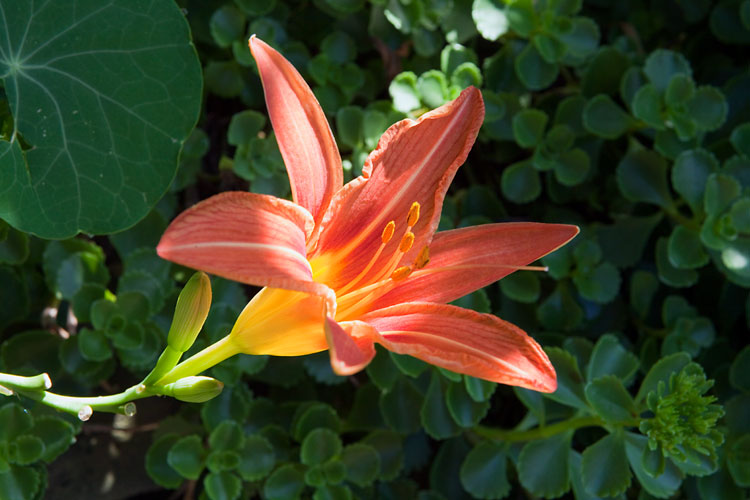
If nosotros take that same image, select the groundwork in an epitome editing plan like Photoshop, and then blur the choice, only the groundwork will blur and the flower volition remain abrupt. The photo below was exported to JPG at the same sixty% quality setting as above and is simply 54 KB—a savings of about thirty% of the file size and so it volition load much faster. In this example, we cease up with a slightly more than creative photo where the focus remains properly on the blossom itself and also achieve significant savings in file size. That'southward a win-win.
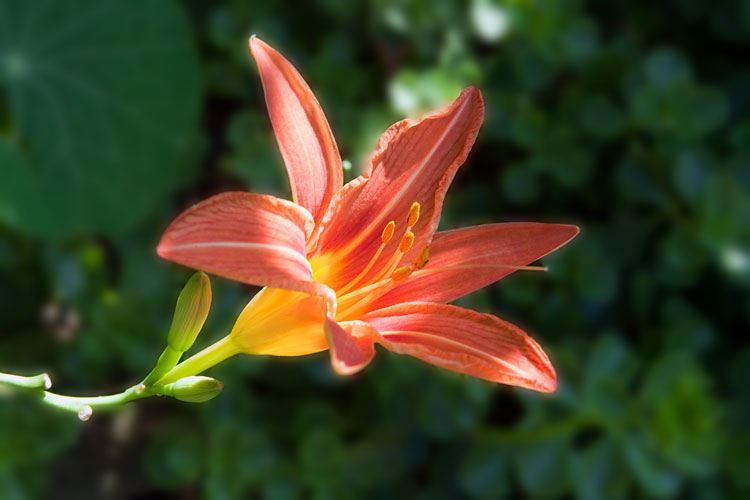
One terminal note most JPG. Recall that this is a lossy format. Every time you save a file as a JPG, you lose quality. If yous think that yous'll ever want to apply the aforementioned photo again, brand certain y'all relieve your original in a format like TIFF or PSD and so merely export the file to JPG. That gives you lot both the compressed JPG to utilize on the Web and your original uncompressed file that you can use again later. The one thing you definitely don't want to do is salvage your just copy of a file as a compressed JPG, reopen it to edit, and save it out once more as a JPG. That's like making photocopies of photocopies. Each time the quality volition get worse. It's always meliorate to become back to your original, uncompressed file.
Compressing a GIF
The traditional option of file type for graphics consisting of simple areas and few colors is GIF, although i can now reach the same results with a PNG-8 (and at a smaller file size).
GIF images are limited to 256 colors, but yous can ready a lower color depth for substantial savings in file size. For the best results try to get at or only under one of the following numbers of colors: 256, 128, 64, 32, sixteen, viii, 4, or two. For example, if your image has 33 colors in it yous'll be able to shave off a lot of the file size if you lot can reduce the palette to 32 colors, but you lot won't get the same savings moving from 32 down to 31 colors.
See "What is bit depth?" for more information and example images.
When you salve (or consign) equally a GIF, first select the number of colors yous want in your final image. Second, if you observe "banding" in areas of gradients, the image probably wasn't a skilful candidate for GIF in the kickoff place but you lot can make the banding less obvious by selecting a dither pattern—usually the "diffusion" pattern will work all-time. Third, if you have transparent areas of your prototype, make sure to select "transparent."
There are a few settings you lot can ignore. Leave "Web snap" set to zero. This setting is a left-over from the days when nearly monitors didn't display the millions of colors that they do today. The "Matte" setting used to be very useful for helping blend the edges of a transparent GIF into the groundwork, but if that's a problem for a detail paradigm, yous should probably switch to PNG anyway.
And, of class, GIF has been the traditional option for animated images, although PNG is poised to take over that area as well.

Sample graphic from FCIT'due south collection of robot illustrations on the TIM website.
Compressing a PNG
We finally get to PNG. Information technology's last on the listing not considering information technology's the least of import, simply considering information technology incorporates features of both JPG and GIF. Its popularity has been growing steadily and, by some estimates, is at present used on more than websites than either JPG or GIF. It may seem a bit more circuitous at first, but if you will be creating web graphics on a regular basis, information technology's certainly worth mastering.
Offset, you'll need to decide whether to export as PNG-8 or PNG-24. PNG-viii is like GIF in that it's best for graphics with few colors and solid areas like logos. The major deviation betwixt PNG-8 and GIF is that the PNG-8 file will more often than not be smaller than a GIF file. PNG-24 is similar to JPG in that it's all-time for continuous-tone images like photographs or other images with more than 256 colors. The major divergence between PNG-24 and JPG is that PNG-24 is lossless so the file size volition be somewhat larger than a JPG, but the quality will exist higher.
Exporting as a PNG-8. If you export to PNG-viii from a graphics plan you will see an interface that is very similar to GIF. Like a GIF, you lot'll demand to select the number of colors (2, 4, eight, 16, 32, 64, 128, or 256), whether to add a dither pattern or not, and whether you need transparency or not. The merely pregnant difference is that the PNG-8 volition be slightly smaller.
Here'south a drawing exported equally a 32-color GIF. The file size is 13.half dozen KB.
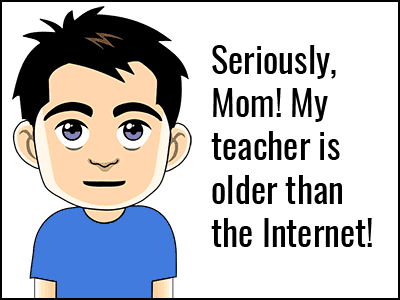
Here'southward the aforementioned drawing exported as a 32-color PNG with exactly the aforementioned settings as higher up. The file size is 10.2 KB. That's a 25% savings in file size.
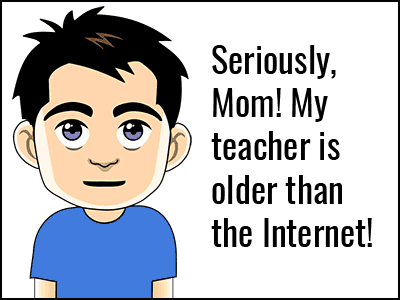
Sample graphic from FCIT's collection of tech cartoons on the TIM website.
Exporting as a PNG-24. Since PNG-24 is a lossless format, you really don't have any options near quality when exporting. Unlike a JPG, no image data is discarded. That also ways the file size can be quite large.
Here'south a photo of macaws exported as a PNG-24. Its file size is 400 KB. That's pretty large.
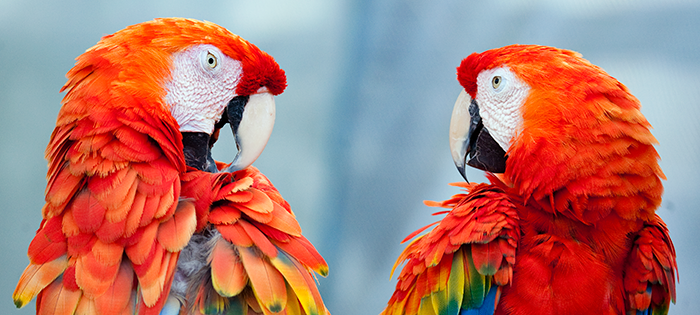
Hither's the same photograph exported equally a JPG at the maximum quality (100%) setting. Its file size is 259 KB.
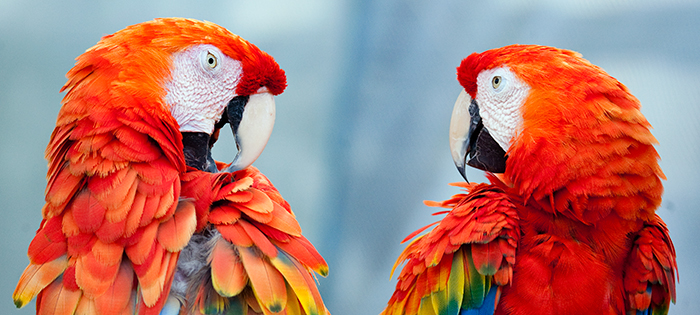
And here's the aforementioned photo exported as a JPG at the high quality (sixty%) setting. Its file size is merely 69 KB.
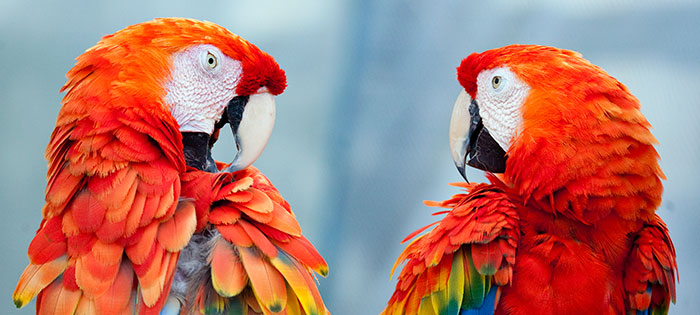
Sample photo from FCIT's collection of stockanimal photos on the ClipPix ETC website.
Wow, if the PNG is 5 or six times the file size of a serviceable JPG, why would I ever want to use it? Well, there could be multiple reasons for choosing the PNG-24 over a JPG.
1. If you lot demand transparency in the image, the PNG is necessary because JPGs don't support transparency.
2. If you desire a lossless format, you'll need the PNG because even at the maximum setting, a JPG loses information and the paradigm degrades even if information technology is non credible at first glance.
three. If you absolutely need a clear prototype with no JPG pinch artifacts, PNG is your option. A skillful instance is a screenshot that includes lots of small type. By its very nature, a JPG is going to "smudge" the type making it slightly harder to read. The PNG will reproduce the type pixel-by-pixel just as information technology appeared originally on the screen.
Related pages
What is the difference betwixt bitmap and vector images?
What is bit depth?
How To Make Picture Smaller File Size,
Source: https://etc.usf.edu/techease/win/images/how-do-i-reduce-the-file-size-of-an-image/
Posted by: carlsonyebbeet79.blogspot.com


0 Response to "How To Make Picture Smaller File Size"
Post a Comment